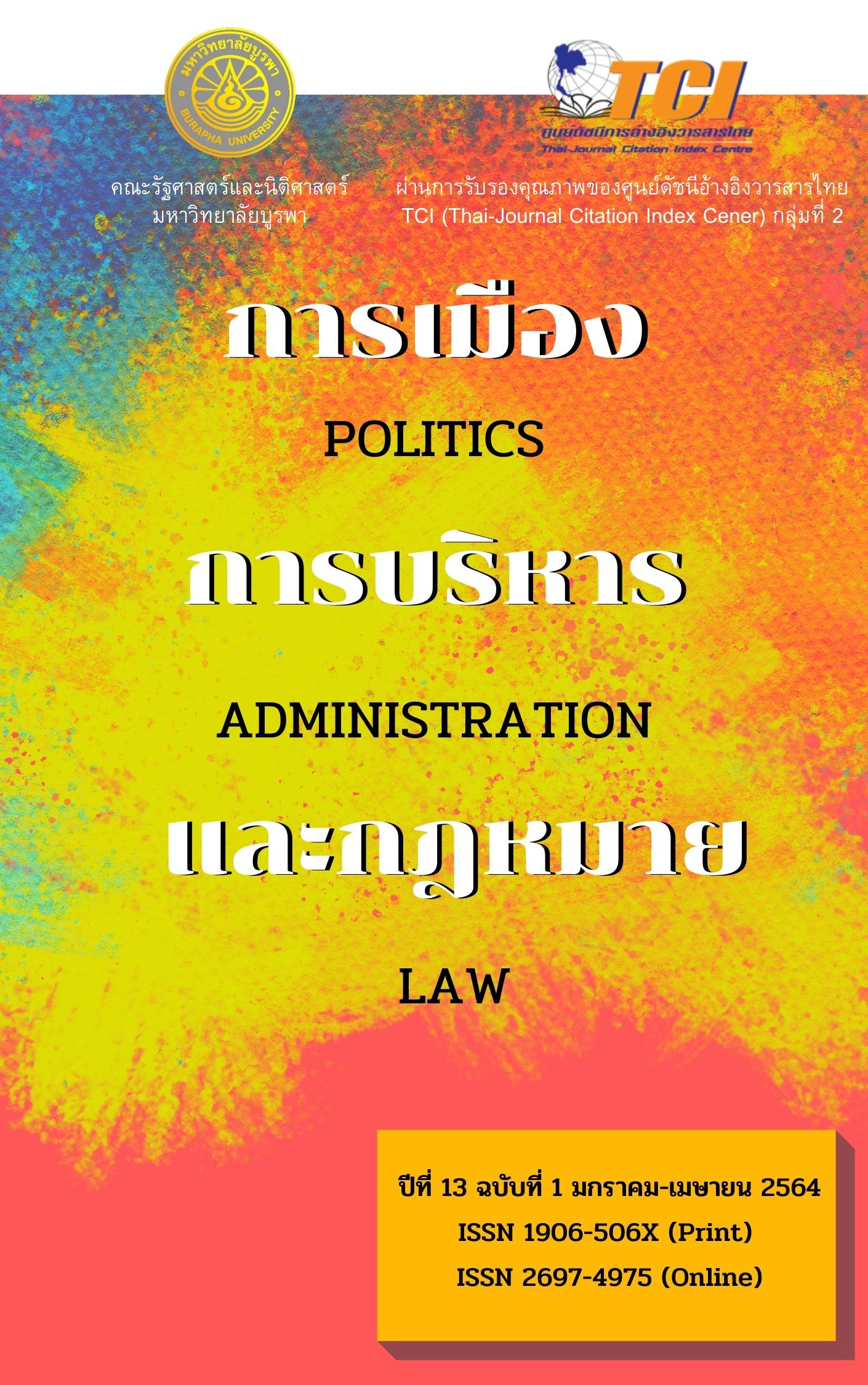The Development of The Law for Management The Geopark of Thailand
Keywords:
Geopark, Geoheritage, ManagementAbstract
In this dissertation, the researcher’s objectives are to study the problems, concepts, and theories related to the management of the geoparks located in the national parks; compare the laws of Thailand and foreign countries concerning the management of geoparks; and draft the law to be appropriate with the management of the geoparks located in the national parks. The qualitative research approach was employed. The data were collected using documentary research, in-depth interviews with twenty-seven subjects; and focus group discussions with ten subjects. Data were analyzed using the techniques of content and comparative analysis. Findings show the conditions of the problems as follows. Although many general laws are applied for the management of geoparks, they do not cover the geoparks located in the national parks. These areas are under the National Park Act, B.E. 2562 (2019). This Act does not stipulate specific provisions concerning the management of the geoparks located in the national parks. Therefore, problems occur in the following manner. Lack of clarity in the authority of the different agencies in the management of the geoparks located in the national parks is found. The scope of the management of the geoparks as a site is not clearly stipulated to be different from the management of the ordinary areas of the national parks. Then, general provisions applicable to the national parks are used inappropriately in the management of the geoparks. Specific policies and plans for the management of the geoparks located in the national parks are not stipulated. Problems are in the structure and qualifications of the National Park Committee. No representatives from agencies who have knowledge and expertise in the management of geoparks participate in the management of the geoparks located in the national parks. There is a problem with the public participation in the management of the geoparks located in the national parks. Income collection, budget, and income allocation in the maintenance of the geoparks also pose problems. A problem is also in the utilization of the geoparks. The authority of government officials in using legal measures as a tool for the management poses a problem as well. The researcher has the following findings. The development of the law for the management of the geoparks located in the national parks must be integrated and collaborated with the agencies. Those who have expertise in geology must be depended on. Public participation is needed to formulate policies and management plans. The operations of officials must be in accordance with the law so the operations are accurate. Basic legal principles must be applied such as the principle of the common heritage of mankind, the principle of prevention, the principle of sovereignty and the government’s duties in maintaining the environment, the principle of sustainable development, the theory of public participation, the principle of common-pool resource management, natural resource management with community participation, and the principle of legality. The researcher has the following recommendations for the development of the law for the management of geoparks in Thailand. The National Park Act, B.E. 2562 (2019) should be amended to stipulate provisions related to the management of the geoparks located in the national parks. This will be an important instrument in the management of the geoparks in order to ensure they can be utilized in a sustainable manner. The issues to be amended involve the definition of the geoparks located in the national parks; the components of the National Park Committee; protection and maintenance; the management of the geoparks; public participation; authorities of government officials; determination of income for maintenance; and the stipulation of the utilization of the geoparks located in the national parks.
References
กฎกระทรวง แบ่งส่วนราชการกรมทรัพยากรธรณี กระทรวงทรัพยากรธรรมชาติและสิ่งแวดล้อม พ.ศ. 2561. (2561, 20 กรกฎาคม). ราชกิจจานุเบกษา. เล่ม 135 ตอนที่ 51
ก. หน้า 6.
กมลินทร์ พินิจภูวดล, กิตติภูมิ เนียมหอม และร้อยโทพันธ์รบ ราชพงศา. (2559). รายงานการศึกษาวิจัยฉบับสมบูรณ์ เรื่อง การพัฒนาอย่างยั่งยืน (Sustainable
Development). กรุงเทพฯ: สถาบันระหว่างประเทศเพื่อการค้าและการพัฒนา (องค์การมหาชน).
กรมทรัพยากรธรณี. (2561). การประชุมสัมมนามหัศจรรย์งานวิจัยสู่การพัฒนาที่ยั่งยืน. เอกสารประกอบการประชุมสัมมนา เรื่อง มหัศจรรย์งานวิจัยสู่การพัฒนาที่ยั่งยืน:
กรณีศึกษาอุทยานธรณีโลก สตูล, 26 กรกฎาคม 2561 ณ โรงแรมเดอะ เบอร์คลีย์ ประตูน้ำ. กรุงเทพฯ: กรมทรัพยากรธรณี.
กรมทรัพยากรธรณี. (2555). แนวทางการจัดตั้งอุทยานธรณี. กรุงเทพฯ: สำนักธรณีวิทยา กรมทรัพยากรธรณีกระทรวงทรัพยากรธรรมชาติและสิ่งแวดล้อม.
กองธรณีวิทยา กรมทรัพยากรธรณี. (2544). ธรณีวิทยาประเทศไทย เฉลิมพระเกียรติพระบาทสมเด็จพระเจ้าอยู่หัว เนื่องในโอกาสพระราชพิธีมหามงคล เฉลิม
พระชนมพรรษา 6 รอบ 5 ธันวาคม 2542. กรุงเทพฯ: กองธรณีวิทยา กรมทรัพยากรธรณี.
กองอนุรักษ์และจัดการทรัพยากรธรณี กรมทรัพยากรธรณี. (2557). แนวทางการอนุรักษ์ทางธรณีวิทยาของกรมทรัพยากรธรณี. กรุงเทพฯ: กองอนุรักษ์และจัดการ
ทรัพยากรธรณี กรมทรัพยากรธรณี.
ชัญชนา คำชา. (2555). แนวทางการนำเสนอแหล่งอนุรักษ์ธรณีวิทยา อุทยานธรณีให้มีความน่าสนใจดึงดูดนักท่องเที่ยว. กรุงเทพฯ: สำนักธรณีวิทยา กรมทรัพยากรธรณี,
ปวริศร เลิศธรรมเทวี. (2559). สิทธิด้านสิ่งแวดล้อมกับรัฐธรรมนูญ. กรุงเทพฯ: นิติธรรม.
พงษ์ศิริ จิตบาน และพรชัย เลื่อนฉวี. (2560). ปัญหาทางกฎหมายเกี่ยวกับระบบการบริหารจัดการอุทยานแห่งชาติในประเทศไทย. วารสารการเมืองการปกครอง, 7(1),
-151.
พระราชบัญญัติอุทยานแห่งชาติ พ.ศ. 2562. (2562, 29 พฤษภาคม). ราชกิจจานุเบกษา. เล่ม 136 ตอนที่ 71 ก. หน้า 145.
รณธี สีแก้ว และยุทธ ศรทัตต์. (2559). การศึกษาวิเคราะห์ความเป็นไปได้ในการกำหนดพื้นที่อุทยานแห่งชาติตะรุเตาเป็นอุทยานธรณี. กรุงเทพฯ: สำนักธรณีวิทยา กรม
ทรัพยากรธรณี.
วิเชียร รุจิธำรงกุล. (2557). บทบาทและกลไกภาครัฐ ภาคเอกชนและภาคประชาสังคมในการแก้ปัญหาสิ่งแวดล้อมของไทย. ดุษฎีนิพนธ์ปรัชญาดุษฎีบัณฑิต สาขาวิชาการเมือง, มหาวิทยาลัยรามคำแหง.
ศุภมิตร จันทะคาม. (2559). รายงานผลการดำเนินงานประจำปีงบประมาณ 2559 (ตุลาคม 2558-กันยายน 2559) เรื่อง การท่องเที่ยวเชิงธรณีวิทยาปรากฎการณ์ใหม่ของการพัฒนาการท่องเที่ยวอย่างยั่งยืน. กรุงเทพฯ: สำนักงานทรัพยากรธรณีเขต 2 (ขอนแก่น) กรมทรัพยากรธรณี กระทรวงทรัพยากรธรรมชาติและสิ่งแวดล้อม.
อุทยานธรณีโคราช. (2560). แนวทางการบริหารจัดการแหล่งธรณีวิทยา แหล่งอนุรักษ์ธรณีวิทยาหรืออุทยานธรณีจังหวัดนครราชสีมา. นครราชสีมา: อุทยาธรณีโคราช.
Brocx, M., & Semeniuk, V. (2007). Geoheritage and geoconservation–history, definition,scope and scale. Journal of the Royal Society of Western Australia, 90, 53-87.
Chakraborty, A. Cooper, M., & Chakraborty, S. (2015). Geosystem as a Framework for Geoconservation: The Case of Japan’s Izu Peninsula Geopark. Geoheritage, 7, 351-363.
English Riviera Geopark. (2019). Site Protection. Retrieved May 25, 2019, from http://www.englishrivierageopark.org.uk
Environmental Protection Law of the People’s Republic of China 2014, (สาธารณรัฐประชาชนจีน). (2014). Retrieved July 20, 2019, from https:// www chinadialogue.net./Environmental Protection-Law-2014-eversion.pdf
National Parks and Access to The countryside Act 1949, (สหราชอาณาจักร). (1949). Retrieved July 20, 2019, from http://www.legislation.gov.uk/ukpga/Geo6/12-13-14/97/data.pdf
Natural Parks Act 1957, (ประเทศญี่ปุ่น). (1957). Retrieved July 20, 2019, from https://www.env.go.jp /en /laws/nature/index.html
Natural Parks Act 2016, (สาธารณรัฐเกาหลี). (2016). Retrieved July 20, 2019, from https://www.elaw.klri.re.kr/kor_service/lawDownload
Ostrom, E. (1990). Governing the Commons: The evolution of institutions for collective action. UK: Cambridge University Press.
Xiao, K. Wahid, U., Momotaz, N., & Nihei, T. (2018). Reviewing Establishment of Legal System for Geoparks in China. Landscape Architecture and Regional Planning, 3(1), 16-22.
Downloads
Published
Issue
Section
License

This work is licensed under a Creative Commons Attribution-NonCommercial-NoDerivatives 4.0 International License.






